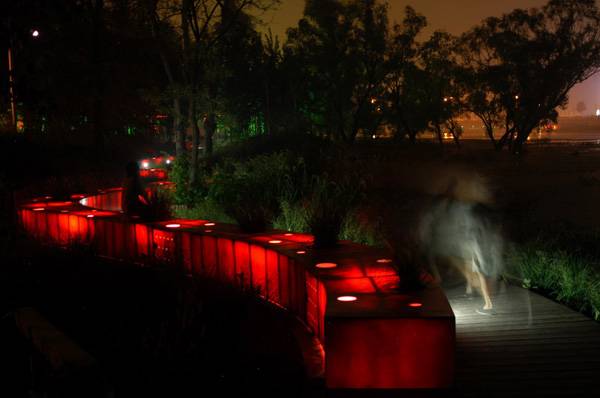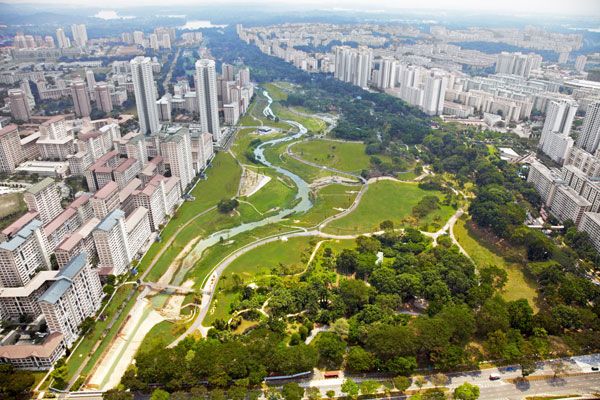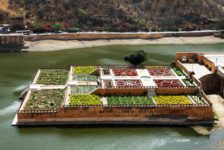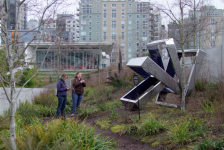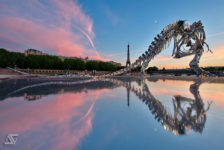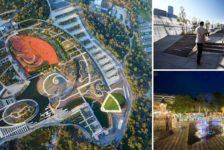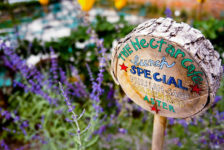As technology and infrastructure improved, rivers became less and less important and more and more forgotten about. We look at 10 cities reconnecting with their rivers. We are living in an era in which for the first time since the industrial revolution we are witnessing a complete shift in the way the relationship between the city and nature is represented in our cities. Architects, planners, landscape designers, artist, politicians and society are getting together to find ways to reintegrate nature into the cities through their often forgotten rivers. Some are pushing away infrastructure or rediscovering abandoned industrial riverside heritage to reintroduce nature and increase the quality of life of the surrounding areas. Other are taking it to a completely new level – thinking of a resilient future relationship with their rivers due to the present climate change impact. We have selected 10 cities that found a way to improve their quality of life and reintroduce nature back into the heart of the city through reinventing the relationship to their rivers.
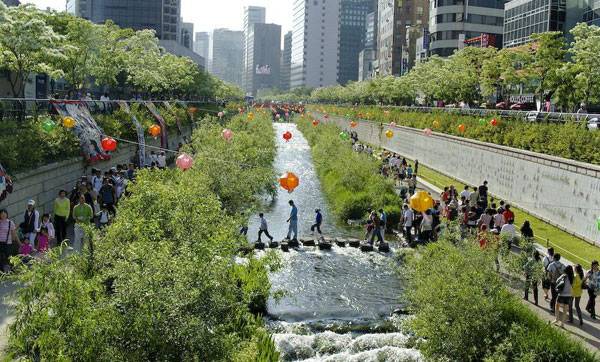
“Korea-Seoul-Cheonggyecheon-2008-01” by stari4ek – originally posted to Flickr as fest2-01. Licensed under CC BY-SA 2.0 via Commons
10 Cities That Are Reinventing The Relationship With Their Rivers
10. Seoul, South Korea – Cheonggyecheon River Project by SeoAhn Total Landscape, completed in 2005
Before becoming a major public gathering place for the people of Seul in 2005, the Cheongycheon River was a highly polluted covered wastewater canal surrounded by elevated and at grade infrastructure dividing the city. The redevelopment of over 11km of the river canal and the destruction of the surrounding infrastructure has not only allowed rediscovering the qualities of the river but also to reinvent the way people relate to it. WATCH: Cheonggyecheon River in South Korea – Best restored river in the world, possibly
The intervention transformed the whole urban experience into a pedestrian friendly, river experience full of activities. The project was designed to address the different levels of the river throughout monsoon season and the rest of the year but is also seen a symbol of the future unification of North and South Korea.
9. Ljubljana, Slovenia, – Ljubljanica river regeneration project, by BB arhitekti, Atelier arhitekti, Urbi, Atelje Vozlič, Dans arhitekti, Trije arhitekti and Boris Podrecca. , completed in 2011
At the beginning of the 20th century, the banks of Ljubljanica River started decaying due to aging infrastructure and the construction of car purposed areas. The river flows directly through the old city center and the deprivation started having a serious negative influence on its vitality.
Realizing the risk of urban deprivation due to the low quality and inaccessibility to the river, the city council decided to invest 20 million euros in the redevelopment of a central portion of Ljubljanica River and recreate its forgotten benefits on the city’s quality of life. The result is a revived city center, additional public spaces by the river and reversing the tendency of urban sprawl evoked by the undermining of the natural qualities the river brings to the city.8. Madrid, Spain, Manzanares river, RIO Madrid project by West 8, completed 2011
Before the completion of the West 8’s project in 2011 the Manzanares river was enveloped on both its banks by high-speed roads. Access to the river was impossible and its valuable recreation qualities buried for the sake of the car. RIO Madrid consisted of drastic measures to bring the river back to the city.

Rio Madrid by West 8. © Municipality Madrid
7. Paris – the transformation of the Seine river banks – “Berges de seine”
Paris is one of the world’s densest cities, with an enormous protected by UNESCO World Heritage Site along the river Seine. Its riverbanks became an automobile corridor in the 60’s when its right banks became exclusively reserved for cars. And it wasn’t until 2001 that the city authorities decided to introduce a temporary way to bring back Parisians to the river where in the past activities flourished and people lived with the river.
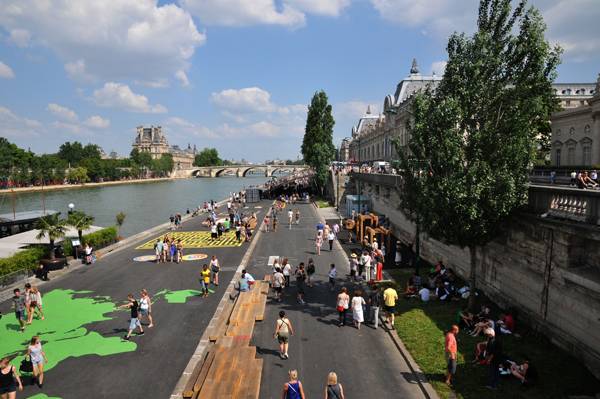
Berges de Seine, Paris, France, by Franklin Azzi Architecture. © FRANKLIN AZZI ARCHITECTURE
6. Tanghe River, Qinhuangdao City, Hebei Province, China, The Red Ribbon Park by Turenscape, completed in 2008
In the case of this project, the river banks weren’t transformed from the industrial history but rather saved from the fast-growing urban development and given a new life with very little interventions. The Red ribbon park creation came just on time to handle the growing need for public space and encroaching urban development.
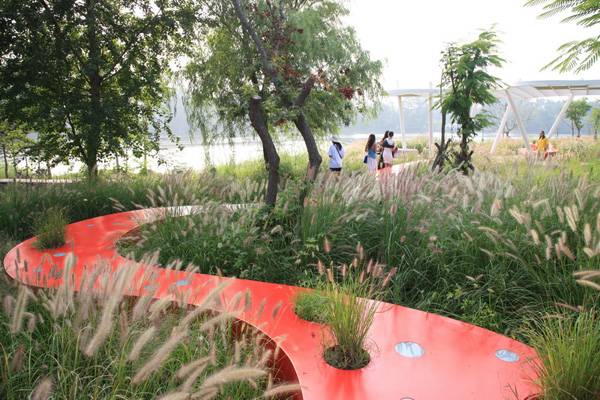
The Red Ribbon Park. Credit: Turenscape
5. Lyon, France – Rhone river redevelopment project, by In Situ Architectes Paysagistes, completed 2007
Rhone River’s history is similar to Bordeaux’s Garonne River, ruled by the automobile and port industry in the past. In 2003, the city council launched a competition searching to create a place along the river that brings people closer to nature and relate to the river while being a meeting place offering a variety of activities. In situ Architectes Paysagistes developed the winning proposal for the redevelopment of 5km of parking spaces and high-speed lanes into a riverfront landscape integrating a variety of activities all along.
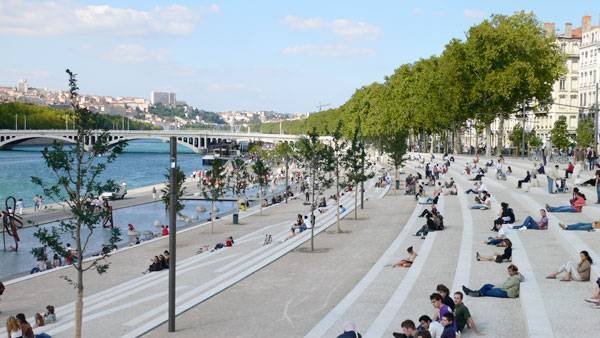
The Lyon River Bank. Credit: IN SITU Architectes Paysagistes.
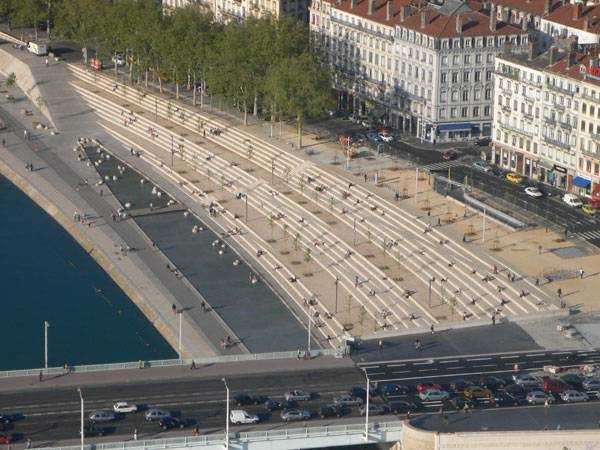
The Lyon River Bank. Credit: IN SITU Architectes Paysagistes.
4. Bordeaux, France – restoration of the left banks of the Garonne river by Michel Courajoud, completed in 2009
As many of the listed cities, Bordeaux’s Garonne river banks were previously devoted to industry. On the left riverbank of the Garonne River in the 1700s, the “Port de la Lune” was located together with a stretch of 4.5 km of adjacent industry along the river right next to the city center. At the beginning of the 20th century, the industrial activities were abandoned and taken over by parking spots. By the year 2005 these ex-industrial areas had no sense of space or meaning. That is when the city saw the potential of transforming it into a vital public space to invite the river back to the city and the people back to the river. In the core of the project was first the creation of a tramway in order to leave more space for pedestrians along the river. Once that was achieved the Major of Bordeaux wanted to create a connection from the river to the adjacent neighborhoods and the opposite banks of the river. He chose the proposals of Michel Courajoud whose aim was to keep the sense of port in a new urban reality achieved by preserving the elements of the old port into the design. With the beginning of the clearance of the area for the construction works people instantly started reaching to the river as “they felt naturally drawn to water” says Courajoud. The most famous feature of the project is the “water mirror” which is the largest reflecting pool in the world. Completed in 2009 these new public spaces have increased the quality of life and provided a completely new urban experience – one close to the river. You can see this project in more detail here.
3. Moscow, Russia – Moskva riverfront regeneration project by Project Meganom consortium 2015
In the search to provide a better quality of life, Moscow starts following the example of other cities rediscovering the added value of the river as part of city’s public spaces. The first step towards reintroducing the river as a public space was taken with a 1 km transformation. The stretch of parking and traffic lanes were substituted by a pedestrian friendly riverside boardwalk with inviting urban furniture, an alley of painters, fountains, an outdoor performance stage, and activities designed for each season. The next step towards bringing Moscow’s life to the river has been taken with the winner project in the international competition 2015. Project Meganom consortium proposed a program for the regeneration of the whole river in Greater Moscow in order to create the green backbone for the future of the capital. The project consists in the creation of public spaces along the river, developing tourism and water transportation through the location of ports linking to the neighborhoods. WATCH: A planning and design overview of Moskva riverfront regeneration project
There is also an idea to naturalize certain sections of the rivers. According to architect Alfonso Vergara- a member of the jury – “if the project is successfully realized Moscow can be a referent for other megacities in the world.”
2. Singapore, Kallang River – Bishan Park by Atelier Dreiseitl, completed in 2012
The project to transform the Kallang river park emerged from the necessity to find larger flood capacity of the canalized Kallang River but also from the initiative of the city to enrich the drainage functions of the canals. The project is part of “ABC water” – coming from Active, Beautiful, Clean waters aiming to create vibrant community gathering spaces accommodating the drainage functions of the river at the same time.
The 2.7km canal was removed to leave space for the naturally meandering river allowing space for its flood capacity to be naturally accommodated while providing access to the river during all of its level changes. From the canal’s destruction, a lookout hill was built to serve as a viewpoint to the newly invited nature. The result is a complete makeover of the way people can relate to the water. It bonded the previously separated communities through the numerous activities the park provides today. WATCH: Kallang River at Bishan Park1. New York, the Hudson river estuary – Rebuild by Design, the Dryline (BIG U), by BIG, in construction
The reason for New York’s need to rethink the relationship with the Hudson River estuary isn’t only the need for public spaces and proximity to the water but the climate change effects that were severely felt due to Hurricane Sandy. BIG’s design team won the 2014 international competition in search of a resilient solution to protect New York from the rising risks of floods due to climate change. Their proposal is an amazing combination of the mentioned above projects but with an upgrade – flood protection. Their solution incorporates a 12km “social infrastructure” to create space for activities and public spaces close to the river which is designed to double as a flood protection wall for future disasters. WATCH: The Dryline – BIG’s vision for New York City
The U ribbon wraps Manhattan in a series of linked landscaped interventions acting as a natural absorbent of eventual high waters while the rest of the time providing a completely new experience surrounded by nature and water a step away from the dense skyscraper reality of Manhattan. If the city finds the budget to build this innovative and multifunctional flood protection it might not only resolve the problem with sea level rise but also provide a new approach on how to reinvent the way our cities interact with their rivers for years to come. – These cities are just a few examples of a new paradigm revealing diverse approaches to how cities should interact with their rivers. They clearly show the need to integrate rivers carefully into their future vision in order to provide the necessary and more demanded public spaces close to nature in our urban reality. Looking for creative solutions to reinvent the functions of the rivers, naturalize them or give them the necessary space and value isn’t making a step backward, but rather a step towards a sustainable and resilient future. Do you think we’ve missed another great example? Share it with us in the comments below! Recommended Reading
- Landscape Architecture: An Introduction by Robert Holden
- Landscape Architecture, Fifth Edition: A Manual of Environmental Planning and Design by Barry Starke
Article by Yuliya Georgieva
Published in Blog



